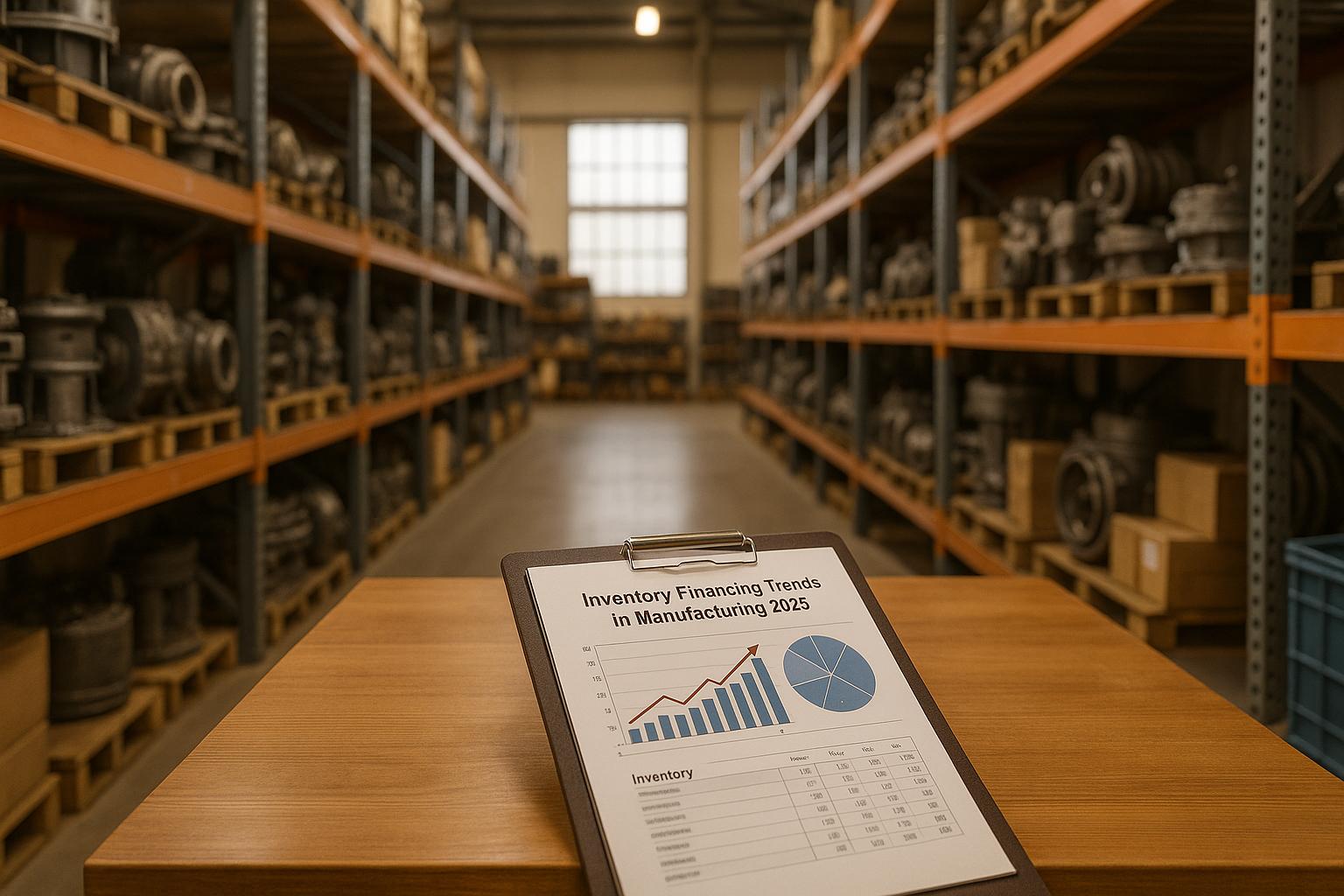Inventory Financing Trends in Manufacturing 2025

Inventory financing is becoming increasingly important for manufacturers in 2025. With rising interest rates, supply chain disruptions, and shifting strategies like nearshoring, businesses must find ways to manage cash flow effectively. Inventory financing offers a way to secure working capital by using stock as collateral, providing flexibility to handle fluctuating production and payment cycles.
Key points:
- What it is: A short-term credit option where inventory serves as collateral.
- Why it’s relevant in 2025: Higher borrowing costs and supply chain shifts have increased the need for flexible financing tools.
- Types: Inventory loans (fixed sum, predictable payments) vs. lines of credit (revolving, interest-only on usage).
- Trends: AI and analytics are improving inventory valuation, while domestic sourcing and "just-in-case" inventory models are reshaping financing needs.
- Challenges: High interest rates, additional fees, and risks tied to inventory valuation fluctuations.
For manufacturers, adopting better inventory management tools and working with financial advisors can streamline the financing process and improve outcomes.
Main Types of Inventory Financing for Manufacturers
In 2025's ever-changing financial environment, choosing the right inventory financing method is essential for manufacturers. With several options available, understanding their differences can help manufacturers address specific cash flow needs and select the best fit for their operations.
Inventory Loans vs. Lines of Credit
Inventory loans provide a fixed sum of money secured by existing inventory. These loans typically have terms ranging from 6 to 24 months, with interest starting to accrue immediately. They’re particularly useful for one-time capital needs, like purchasing bulk raw materials or preparing for a seasonal surge.
The predictable repayment schedule makes budgeting simpler, but there’s a downside: you’re paying interest on the full loan amount, even if you don’t need all the funds right away. This can lead to higher costs when your cash flow requirements vary.
On the other hand, inventory lines of credit offer greater flexibility. Instead of a lump sum, you gain access to a revolving credit line that you can draw from as needed. You only pay interest on the amount you use, and as you repay the borrowed funds, the credit becomes available again. The credit limit, generally 50% to 80% of your eligible inventory value, adjusts based on your current inventory levels.
This revolving structure is ideal for manufacturing’s cyclical nature. When production ramps up, you can borrow more. As sales convert inventory into cash, you can repay the credit line to lower interest costs. Typically, lines of credit require monthly interest payments, with the principal due when the term ends - usually within one to three years.
| Feature | Inventory Loans | Inventory Lines of Credit |
|---|---|---|
| Payment Structure | Fixed monthly payments | Interest only on funds used |
| Flexibility | Limited - lump sum upfront | High - draw as needed |
| Best For | Large, specific purchases | Ongoing working capital needs |
| Interest Costs | Higher - paid on full amount | Lower - paid only on usage |
| Repayment | Fixed term (6–24 months) | Revolving (1–3 year terms) |
This comparison highlights how each option aligns with different production and cash flow scenarios.
How Purchase Order Financing Differs
Purchase order financing works differently, focusing on funding production before inventory even exists. This method allows manufacturers to cover upfront production costs based on confirmed purchase orders from customers. A financier advances up to 80% of the order’s value to pay suppliers. Once production is complete and goods are shipped, the financier collects payment from the customer and releases the remaining amount, minus fees.
This type of financing is especially helpful for manufacturers who have secured orders but lack the cash to fulfill them. It’s particularly useful for handling large orders, dealing with customers who have extended payment terms, or scaling production beyond typical capacity.
The main distinction lies in timing and collateral. Unlike traditional inventory financing, which requires you to already own the inventory, purchase order financing helps you acquire the materials needed to produce it. Here, the collateral is based on the purchase order itself rather than physical goods.
However, purchase order financing tends to be more expensive, with costs ranging from 2% to 6% per month. The higher cost reflects the increased risk, as financiers rely on your ability to complete production and your customer’s ability to pay, rather than tangible inventory they can liquidate.
This option is best for manufacturers with reliable operations and strong customer relationships. It’s less suitable for businesses with inconsistent production quality, late deliveries, or customers with shaky payment histories.
Many manufacturers use purchase order financing as a stepping stone. Once they’ve built up inventory levels and established more predictable cash flow, they can transition to more affordable inventory-based credit options that provide greater flexibility and lower costs.
Major Inventory Financing Trends in 2025
Economic challenges are pushing up the cost of borrowing for manufacturers looking to finance their inventory.
Higher Interest Rates and Borrowing Costs
By mid-August 2025, the Federal Reserve's effective federal funds rate stands at 4.33%. While this marks a drop from 5.33% a year ago, it’s still hovering close to the long-term average of 4.61%, keeping borrowing expenses elevated for manufacturers[1]. Adding to the pressure, inflation in industrial inputs and services continues to rise, with producer prices increasing by 0.9% monthly and 3.3% annually as of July 2025[1]. However, there’s some relief on the horizon, as market predictions suggest potential rate cuts as early as September 2025. These factors highlight the need for manufacturers to refine their financing approaches to better manage these economic shifts.
Pros and Cons of Asset-Based Inventory Lending
In the financing world of 2025, asset-based lending has become an important - though not without its challenges - option for manufacturers. Asset-based inventory lending offers quick access to capital, but it also comes with risks that could impact long-term financial health. For manufacturers looking to secure funding in today’s market, understanding these advantages and disadvantages is essential.
One of the biggest benefits is the ability to tap into cash flow through inventory, especially when traditional credit options are limited. This can be a lifeline for businesses dealing with short-term cash flow issues.
On the flip side, borrowers often face higher interest rates along with extra costs for appraisals, servicing, and monitoring. These added expenses can make the actual cost of borrowing much higher than it initially appears.
Another potential pitfall is the risk of losing assets if payments are missed, which could disrupt operations. Continuous asset valuation during market fluctuations can also restrict borrowing capacity. Additionally, inventory that is specialized or hard to sell often receives lower valuations, reducing the amount of capital manufacturers can secure.
Comparison Table: Benefits vs. Drawbacks
| Benefits | Drawbacks |
|---|---|
| Fast access to capital by using inventory as collateral | Higher interest rates and fees for appraisals, servicing, and monitoring |
| Easier credit approval compared to traditional loans | Risk of losing assets if payments are missed |
| Flexible borrowing amounts tied to inventory value | Frequent asset valuations can limit borrowing during market shifts |
| Improved cash flow for operations or growth | Restrictive loan terms that reduce financial flexibility |
| No ownership dilution as opposed to equity financing | Risk of over-borrowing if asset values drop below debt levels |
| Limited collateral options for specialized or niche inventory |
While asset-based lending can provide much-needed liquidity, it comes with trade-offs that require careful consideration. One key risk is over-collateralization - if the value of pledged assets decreases, manufacturers could find themselves in a precarious financial position, with more debt than equity.
To manage these challenges, manufacturers need strong cash flow strategies. This includes choosing lenders with transparent and favorable terms, regularly reviewing asset valuations, and diversifying funding sources. These steps can help reduce risks, ensure timely payments, and create financial buffers for unexpected situations.
Negotiating loan terms upfront is equally important. Manufacturers should aim for flexibility in collateral requirements, repayment schedules, and financial ratio expectations. Aligning loan terms with business operations and growth plans can make asset-based lending a far more effective financing tool.
sbb-itb-e766981
How to Get Inventory Financing
Securing inventory financing in 2025 requires careful preparation and a clear demonstration of your financial health and inventory performance. Manufacturers need to provide detailed documentation to help lenders evaluate risk and determine suitable credit lines.
Meeting Lender Requirements
Lenders typically want to see a full picture of your financial and inventory management before approving financing. This includes audited financial statements, cash flow projections, and inventory reports that highlight turnover rates and aging. They often assess how efficiently your inventory moves and may adjust advance rates depending on the type and liquidity of your stock.
A strong credit history and consistent profitability are essential. Additionally, lenders pay close attention to working capital metrics like accounts receivable and supplier payment terms. By meeting these standards, you not only increase your chances of approval but also position yourself as a reliable borrower.
Using Technology for Better Inventory Management
Once your documentation is in order, technology can give you an extra edge. Lenders appreciate businesses that use tools like Enterprise Resource Planning (ERP) software, barcode or RFID tracking, and cloud-based financial systems. These tools allow for real-time inventory tracking and automated reporting, providing lenders with accurate and up-to-date insights. By adopting these technologies, manufacturers not only simplify the financing process but also show they can manage inventory risks effectively.
Common Mistakes to Avoid
When applying for inventory financing, steer clear of these common errors:
- Weak Record-Keeping: Incomplete or inaccurate financial and inventory records can weaken your application.
- Overleveraging Inventory: Borrowing too much against inventory without considering market shifts or seasonal demands can lead to repayment issues.
- Ignoring Restrictive Covenants: Failing to monitor terms like borrowing base calculations, minimum inventory levels, or financial ratios can create operational headaches.
- Overlooking Fees: Costs like monitoring and appraisal fees can add up, so make sure to account for them.
- Inconsistent Communication: Regular, accurate updates to lenders are crucial. Poor communication can lead to compliance problems.
- Lack of Funding Diversification: Relying solely on inventory financing can leave you vulnerable during market downturns. A diversified funding strategy is a safer approach.
To navigate the complexities of inventory financing, consider working with experienced financial advisors. Teams like Phoenix Strategy Group specialize in helping companies secure capital, scale operations, and develop tailored financing strategies. They combine financial expertise with advanced technology and data-driven insights to support your business needs. Learn more at Phoenix Strategy Group.
How Financial Advisors Help with Inventory Financing
Navigating the world of inventory financing in 2025 can be challenging, but working with seasoned financial advisors can turn this complexity into a strategic advantage. These professionals bring deep expertise in manufacturing finance and lender expectations, which many business owners may not have. Their insights not only help secure better terms but also ensure that financing aligns with broader business objectives.
Securing Better Financing Terms with Expert Guidance
Financial advisors excel at preparing manufacturers with the exact documentation lenders need, crafting strong financial presentations that improve the chances of securing favorable terms. They understand what banks and alternative lenders are looking for and know how to position your business in the best possible way.
Take Phoenix Strategy Group as an example. They use an Integrated Financial Model that combines real-time data with forward-looking projections. This approach gives manufacturers a clear, accurate financial snapshot, addressing lender concerns about inventory risks and cash flow stability. Their fractional CFO services also help businesses maintain the financial discipline and reporting standards that lenders expect throughout the financing process.
When it comes to negotiations, having professional support makes a big difference. Advisors are well-versed in market rates, fee structures, and covenant terms across various inventory financing options. They can pinpoint the lenders most likely to approve your application and help you avoid costly mistakes, such as agreeing to restrictive borrowing base calculations or excessive monitoring fees.
Beyond securing financing, advisors focus on aligning credit strategies with your company’s overall goals. Instead of simply finding any available credit line, they evaluate how inventory financing fits into your capital structure and growth plans. This thoughtful approach often leads to better terms and more flexible arrangements that support long-term success.
Leveraging Data Analytics and Real-Time Reporting
Modern financial advisors use advanced analytics to drive better financing outcomes.
For instance, Phoenix Strategy Group's Monday Morning Metrics system integrates real-time financial data from multiple platforms, giving manufacturers weekly insights into key inventory metrics. This level of visibility enables businesses to proactively manage their financing relationships, addressing potential issues before they escalate.
Data analytics also play a crucial role in continuously improving financing arrangements. By monitoring key performance indicators over time, advisors can identify opportunities to renegotiate terms, adjust borrowing patterns, or transition to financing structures that better suit the business as it grows and proves its reliability. These tools make financing more flexible and responsive to changing needs.
When paired with expert guidance, advanced analytics transform inventory financing into more than just a means to secure credit. They turn it into a strategic tool for growth, helping businesses reduce risks and costs while staying aligned with their long-term goals.
Conclusion: Managing Inventory Financing in 2025
As we look at inventory financing in 2025, the landscape is shaped by rising interest rates, AI-powered underwriting, and evolving supply chain dynamics. Thriving in this environment goes beyond simply knowing traditional lending options - it calls for a thoughtful strategy that blends market insights, advanced technology, and expert advice.
With real-time data analytics, lenders can now evaluate inventory and cash flow with remarkable accuracy. Manufacturers who embrace these tools gain a clear advantage, as data-driven decisions are becoming a key factor in securing favorable financing terms.
The shift toward domestic sourcing and just-in-time production has also reshaped credit structures. Manufacturers who align with these changes can better appeal to lenders adapting their criteria to meet the demands of shorter, more efficient supply chains.
Navigating this complex financing environment requires professional expertise. Financial advisors with a deep understanding of manufacturing finance can help businesses meet lender expectations, refine borrowing strategies, and align financing with overall business goals. For instance, Phoenix Strategy Group uses advanced analytics and strong lender relationships to help manufacturers secure the best financing options available.
In 2025, manufacturers who combine market awareness, cutting-edge technology, and expert partnerships are better positioned to access the capital and flexibility needed for growth. This forward-thinking approach enables businesses to tackle financing challenges head-on and adapt to the evolving industry landscape.
FAQs
What’s the best way for manufacturers to choose the right inventory financing option in 2025?
To select the best inventory financing option in 2025, manufacturers need to start by evaluating their cash flow requirements, available collateral, and long-term business objectives. If you're looking to make a large, one-time inventory purchase, a term loan might be the way to go. These loans provide a lump sum with fixed repayment terms, making them ideal for predictable financing needs. For businesses with fluctuating inventory demands, a line of credit offers more flexibility, giving you access to funds as needed.
As you weigh your options, pay close attention to factors like interest rates, repayment terms, and collateral obligations. This will help ensure the financing choice supports your operational goals and aligns with your overall financial plan.
How is technology transforming inventory management and helping manufacturers secure better financing?
Technology is transforming inventory management by introducing real-time tracking, automation, and smarter decision-making through tools like AI, IoT, and integrated platforms. For example, AI enables manufacturers to fine-tune procurement processes and uncover cost-saving opportunities. Meanwhile, IoT devices provide precise tracking of inventory levels, which helps cut down on waste and streamlines supply chain operations.
These innovations are also reshaping how manufacturers access financing. With detailed, up-to-the-minute inventory data, companies can present a lower risk profile to lenders. This transparency makes it easier to negotiate more favorable financing terms and secure the credit needed to drive growth.
How can financial advisors help manufacturers manage inventory financing challenges during periods of high interest rates?
Financial advisors are essential allies for manufacturers tackling inventory financing, especially when interest rates climb. They can suggest asset-based lending solutions, like inventory loans or lines of credit, which often come with more adaptable borrowing terms. These options can ease financial strain while ensuring access to necessary funds.
Advisors can also assist in refining tax strategies. For instance, they might recommend taking advantage of capitalized interest deductions to help offset some of the financial burden.
On top of that, improving inventory management practices can make a significant difference. By reducing carrying costs and boosting cash flow, businesses can better handle financial pressures. Fractional CFOs or financial advisors often play a key role here, helping manufacturers tweak supply chain strategies to maintain liquidity and keep growth on track, even as borrowing costs rise.




